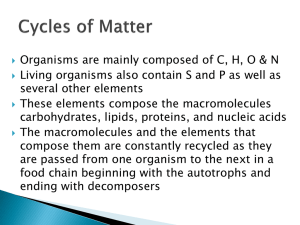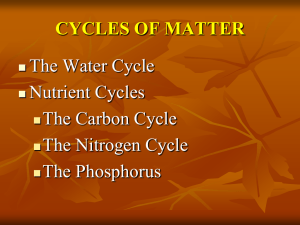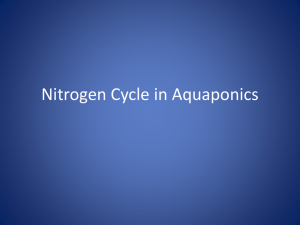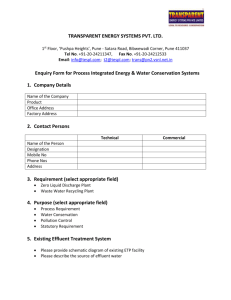now
advertisement
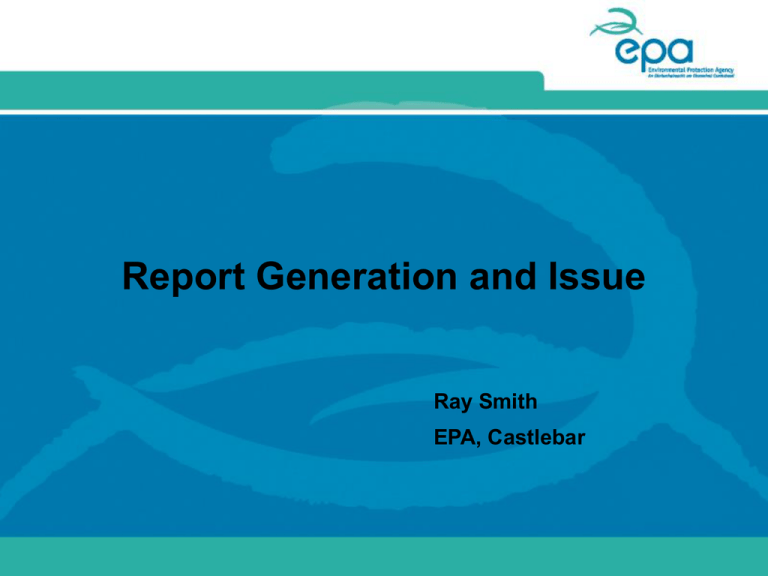
Report Generation and Issue Ray Smith EPA, Castlebar Presentation Outline Reporting Requirements General Sampling Laboratory Analysis Units of Measurement General Issues Total Nitrogen / TON / Nitrate / Nitrite / Ammonia O-Phosphate / Total Phosphorus Reporting Requirements - General Report Title (e.g. Test Report) Unique Identification Number (e.g. Serial Number) Issue Number Name, function & signature of person who authorises the Test Report Reporting Requirements - Sampling Date & Time of Sampling Name / Address of Sampling Location (Licensee) Identification of Sampling Point (e.g. SW1, SE1 etc.) Type of Sample (i.e. Composite / Grab) Composite Period (times) Total Flow (m3) over the time period (normally 24 hours) Calculated Flow (m3/hour) Some licences also have limit m3/day Reporting Requirements - Sampling Field Measurements Indication of tests carried out in the field Temperature, DO, Residual Chlorine etc. Process Conditions at time of Sampling Production equipment broken down Maintenance being carried out Anything abnormal that may impact on discharge Weather Conditions Reporting Requirements – Lab Analysis Date of Sample Receipt in Laboratory Sample Storage / Preservation How long are samples held before analysis What Preservation techniques are used Refrigeration Freezing Preservation with Acid / Base Analysis Methods used Reference to the Standard Method on which it is based APHA / US EPA / ISO / Blue Book etc. Laboratory developed method Reporting Requirements – Lab Analysis Accreditation status of each Test Parameter Name Should be unambiguous Ammonia as N or NH3 Total Oxidised Nitrogen or Nitrate Total or Dissolved Conductivity @ 200C or 250C Should be as per licence Test Results & Units of Measurement Reporting Requirements – Lab Analysis Measurement Uncertainty & Limit of Quantitation Deviations from quality criteria / method Full QC criteria not met Calibration criteria not met Normal procedure not followed for whatever reason Subcontracted Tests Reporting Requirements Reporting Requirements Scope & Accuracy of Analysis Parameter Units Limit of Quantitation (LOQ) Uncertainty (95%) Biochemical Oxygen Demand Colour Conductivity pH Turbidity Suspended Solids Total Solids Total Dissolved Solids Chemical Oxygen Demand (COD) * Total Hardness Alkalinity mg/l O2 Hazen S/cm pH unit NTU mg/l mg/l mg/l mg/l O2 mg/l CaCO3 mg/l CaCO3 1.0 5 15 0.1 0.5 8 30 60 25 30 8 + 18.7 % + 5.2 % + 1.6 % + 0.1 pH + 8.5 % + 10.8 % + 10.6 % + 12.5 % + 10.7 % + 6.1 % + 5.3 % Ammonia * Chloride Total Oxidised Nitrogen (TON) * o-Phosphate Nitrite Silica Fluoride Nitrate * Sulphate Total Phosphorus mg/l N mg/l Cl mg/l N mg/l P mg/l N mg/l Si mg/l F mg/l N mg/l SO4 mg/l P 0.03 2 0.4 0.012 0.005 0.1 0.03 0.05 0.5 0.01 + 8.5 % + 6.6 % + 12.6 % + 10.0 % + 12.3 % + 6.6 % + 8.9 % + 5.2 % + 3.4 % + 9.3 % Reference Test Method APHA Section 5210 B APHA Section 2120 APHA Section 2510 APHA Section 4500 H+ APHA Section 2130 B APHA Section 2540 D APHA Section 2540 B APHA Section 2540 C APHA Section 5220 D APHA Section 2340 C APHA Section 2320 B/ Blue Bk HMSO 0117516015 Blue Bk HMSO 0117516139 APHA Section 4500-Cl E APHA Section 4500-NO3 H APHA Section 4500-P E APHA Section 4500-NO2 B APHA Section 4500-SiO2 D APHA Section 4110 APHA Section 4110 APHA Section 4110 APHA Section 4500-P B & E Maximum Storage Period (before analysis) Sample Preservation 35 hours 35 hours 35 hours 35 hours 35 hours 7 days 7 days 7 days 35 hours 35 hours 35 hours Refrigeration Refrigeration Refrigeration Refrigeration Refrigeration Refrigeration Refrigeration Refrigeration Refrigeration Refrigeration Refrigeration 35 hours 35 hours 35 hours 35 hours 35 hours 28 days 28 days 35 hours 28 days 28 days Refrigeration Refrigeration Refrigeration Refrigeration Refrigeration Refrigeration None Refrigeration Refrigeration Freezing Units of Measurement – General Common Data Issues Parameter Names Units of Measurements Units of Measurement Issues mg/l instead of µg/l (easy to identify) Nitrate as NO3 instead of N (less easy to identify) Ammonia as NH3 instead of N (very difficult to identify) Units of Measurement – Nitrogen Forms Total Nitrogen = Inorganic Nitrogen + Organic Nitrogen Total Oxidised Nitrogen + Ammonia (TON) Nitrate (NO3) + Nitrite (NO2) Also: Unionised Ammonia (NH3) + Ionised Ammonia (NH4+) (Ammonium) Total Kjeldahl Nitrogen (TKN) = Organic Nitrogen + Ammonia = Total Nitrogen – Total Oxidised Nitrogen Units of Measurement – Nitrogen Forms Ammonia NH3 + H2O ↔ NH4+ + OH– (Unionised) (Ionised) ● Temperature & pH dependent pH % Unionised Ammonia (NH3) @ 200C 5 0.004 6 0.04 7 0.39 8 3.8 9 11.1 10 79.8 Units of Measurement – Nitrogen Forms Ammonia commonly determined using Colorimetric methods Measures total ammonia Can be reported as mg/l NH3, mg/l NH4 or mg/l N Conversion Factors Convert From Convert To Divide By mg/l NH3 mg/l N 1.22 mg/l NH4 mg/l N 1.29 Units of Measurement – Nitrogen Forms Conversion from mg/l NH3 to mg/l N = (Atomic Weight Nitrogen) + (3 x Atomic Weight of Hydrogen) Atomic Weight Nitrogen = (14.01) + (3 x 1.008) 14.01 = 1.22 Units of Measurement – Nitrogen Forms TON & Nitrate can be reported as mg/l NO3 or mg/l N Nitrite can be reported as mg/l NO2 or mg/l N Total Nitrogen generally reported as mg/l N Conversion Factors Convert From Convert To Divide By mg/l NO3 mg/l N 4.43 mg/l NO2 mg/l N 3.28 Units of Measurement – Nitrogen Forms TON / Nitrate conversion from mg/l NO3 to mg/l N = (Atomic Weight Nitrogen) + (3 x Atomic Weight of Oxygen) Atomic Weight Nitrogen = (14.01) + (3 x 16) 14.01 = 4.43 Units of Measurement – Phosphorus Forms Phosphorus in natural waters & wastewaters is usually found in the form of phosphates (PO43). Inorganic form (including orthophosphates and condensed phosphates) Organic form (organically-bound phosphates) Orthophosphate commonly determined colorimetrically (using ammonium molybdate method) Molybdate Reactive Phosphorus (MRP) Total Phosphorus – Digestion followed by o-phosphate measurement Units of Measurement – Phosphorus Forms Commonly reported as mg/l PO4 or mg/l P (sometimes P2O5) To Convert from mg/l PO4 to mg/l P divide by 3.07 = (Atomic Weight Phosphorus) + (4 x Atomic Weight of Oxygen) Atomic Weight Phosphorus = (30.974) + (4 x 16) 30.974 = 3.07 Units of Measurement - Analysis Desirable to measure in same units as per licence Nitrogen Forms (mg/l N) Phosphorus Forms (mg/l P) Calibration / QC Standards must be prepared in these units No Conversion factors involved Calibration / QC Standards Buy in prepared standard or prepare from a salt Concentration Units are very important Units of Measurement - Analysis Task: Prepare 1L of Ammonia Standard 1000 mg/l as N Salt : Ammonium Chloride (NH4Cl) Question: What weight of Ammonium Chloride is required? = (Atomic Wt Nitrogen) + (4 x Atomic Wt of Hydrogen) + Atomic Wt of Chlorine Atomic Weight Nitrogen = 14.01 + (4 x 1.008) + 35.5 14.01 = 3.822 Dissolve 3.822g of Ammonium Chloride in deionised water and dilute to 1 litre - 1000 mg/l Ammonia as N Summary Important that as much information as possible is provided in reports Adds greater context to sampling and analysis process Aids the interpretation of results Greater attention needs to be paid to measurement units Ammonia Total Oxidised Nitrogen Nitrate Nitrite Total Nitrogen o-Phosphate Total Phosphorus ……and finally Thank You!

